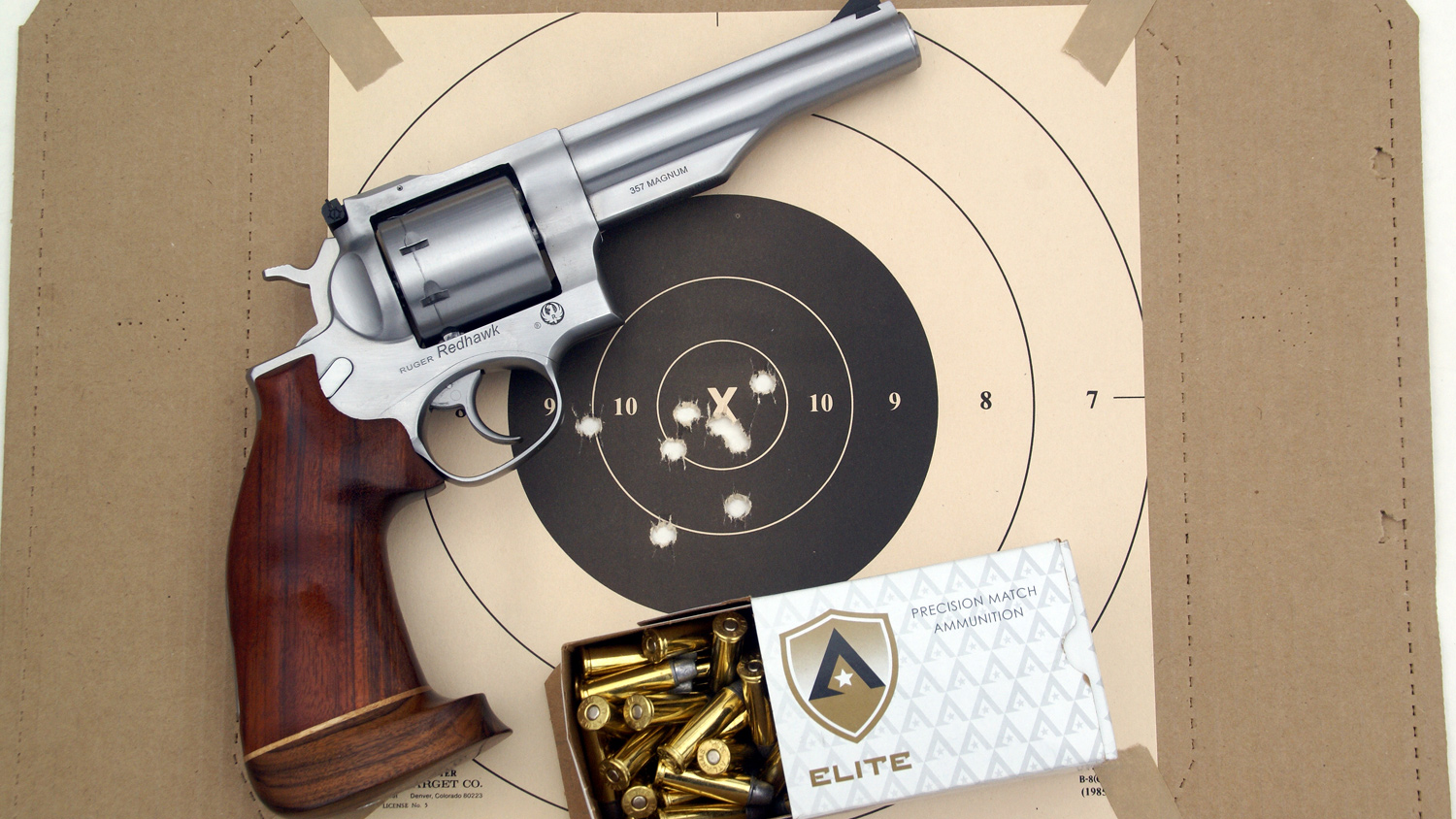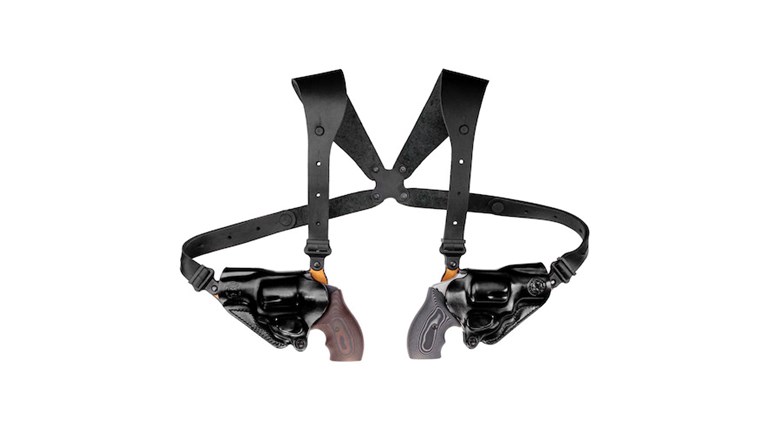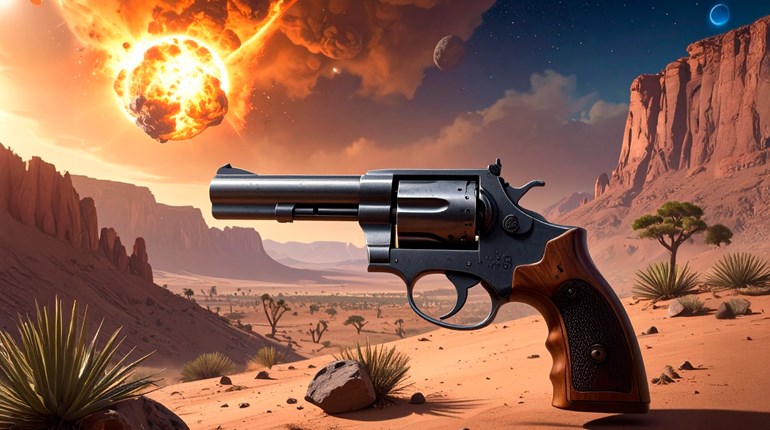
Introduced in 1980, the Ruger Redhawk was the company’s first big bore double action (DA) revolver. Like the Ruger Security Six, the Redhawk was built with an innovative one-piece frame that dispensed with the removable side plate and provided superior strength. In addition, it used a new latch at the crane which firmly locked the cylinder in place at front, rear, and bottom, also incorporating modern coil springs—instead of the more commonly used leaf springs.

Originally chambered for the .44 Magnum, in barrel lengths of 5.5- and 7.5-inches, it was a robust design intended for long term use with stout magnum loads. It quickly became a favorite with handgun hunters. The 2018 introduction of the Redhawk eight-shot .357 Magnum (#05060, $1,079) with a 5.5-inch barrel may very well make it a favorite with competitive revolver shooters.
The Gun
The eight-shot Redhawk .357 is built on the standard Redhawk frame, with a square butt grip. Constructed from stainless steel, with a satin finish, it features an unfluted cylinder. The heavy barrel is 5.5-inches (1:18.75; right-hand twist with 5-groove rifling) with a match crown, and a half underlug housing the ejector rod. The front sight is a red ramp dovetailed into the barrel, allowing for easy replacement for those who don’t favor a red ramp. The rear sight is Ruger’s fully-adjustable model, with a white outline rear blade. The trigger is nicely-radiused for double action work. The grip panels are slender, uncheckered hardwood that match the grip frame contours.

Of note to competitive shooters who require fast reloads, the cylinder is cut for moon clips and three are supplied with the gun, although the gun will function just fine without them. Additional clips are available from Ruger. My tests with S&W 627 moon clips holding fired Short Colt cases indicate that it will not accept 627 moon clips.
It’s a robust gun, with an empty weight of 49 ounces and an overall length of 11 inches. The single action pull measured 6.6-pounds on my digital trigger gauge and the double action pull exceed the gauge’s 12-pound limit. An “educated guess” would put it in the 14-pound range, although it was extremely smooth. That’s heavy for a competition revolver, but Wolff offers an inexpensive trigger spring kit that can lighten it up.
On the Range
Selecting test ammo for the Redhawk was a bit more complicated than usual because of the wide range of competitive roles it can play. It’s very much at home in USPSA, Steel Challenge, and ICORE—although not a legal gun for IDPA competition.

USPSA (where 8-shot Minor caliber guns have come to rule Revolver Division) requires a minimum 125 Power Factor (PF). One of the few factory loads that makes the 125 PF is the Speer 158-grain Lawman +P (140 PF), so I included that along with my Bayou Bullet 135-grain RN 130 PF handload.
ICORE requires a 120 PF, and Federal’s 158-grain LRN American Eagle, Aguila’s 130-grain FMJ, and Remington’s 158-grain LRN Target Pistol/Revolver are legal loads there—although they won’t make 125 PF for USPSA.
Steel Challenge has no PF requirements, so I included my Bayou 120-grain “Mouse Puff” 110 PF handload, and also Atlanta Arms 158-grain LSWC PPC load, which comes in at about a 118 PF.

The first step was to zero the gun from a 25-yard bench rest with the Atlanta Arms load. It was about four inches low initially, with the windage on. A few clicks with a screw driver zeroed the elevation. The heavy gun produced little recoil.
Double action work on multiple targets, from seven to 20 yards was next. I quickly found that the slender wooden “handles” were not going to be to my liking. They didn’t produce a “locked-in grip,” allowing the gun to shift in my hand.
My dislike of factory grips (on any revolver, from any maker) isn’t unusual. Most competitive revolver shooters feel the same way and routinely replace the grips. I was intrigued by the gun, so I contacted Hogue and arranged for a set of their Big Butt grips. They look odd at first glance, but are legal in USPSA, ICORE, and Steel Challenge. They’re also favored by many top shooters because they will positively lock the gun into your hand.
With the Big Butt grips installed, accuracy testing from a 25-yard sandbag rest was next. It was a bit challenging to maintain total focus through a full eight-round cylinder, but the resulting chart will show the Redhawk has more than enough accuracy for action pistol competition when fed quality ammunition. What little muzzle rise the heavy gun had was further reduced by the positive grip on the Big Butt, and it was almost like shooting a .22LR. After that it was double action play time, and things got fun!

One of the first rapid DA drills was a full eight-round Bill Drill on an NRA Slow Fire Pistol target at 10-yards. Lacking a suitable holster, I started at a Low Ready, set my Pact Timer on delay, and at the BEEP I emptied the gun DA as fast as I could keep the front sight on the 5.5-inch black bull. Multiple runs showed (even with the heavy trigger) times running from 3.76 to 3.91 seconds. The locked-in grip and heavy weight made muzzle rise virtually nonexistent. The eight-shot groups were gratifyingly compact—averaging about six inches vertically by four inches horizontally. That will stay in the A Zone of a USPSA or ICORE target.
Eight-shot Minor caliber revolvers dominate USPSA, as well as Limited and Open Divisions in ICORE, but are also very effective in Steel Challenge. You can run hard and get two misses before you have to slow down and make deliberate hits, as opposed to the one miss that a six-shot gun allows. Lacking a legal holster, I wasn’t able to shoot it in a match, but I did get to my club on a “practice day” when they had Roundabout set up. I started with my .22LR optical sight pistol from the normal Low Ready position to get a “time line.” Then, I shifted to the Redhawk from the same Low Ready position. My times with the Redhawk weren’t far behind the A Class times I was recording with the .22LR! The heavy gun tracked smoothly, and the locked-in grips kept the sights on the target.
No revolver is truly ready for upper level competition as it leaves the factory. At least not for discriminating shooters. But the new eight-shot Redhawk doesn’t take much. Add some comfortable grips, maybe a spring kit, and it’s ready for any match.
Accuracy Chart
Accuracy tests conducted from a 25-yard sandbag rest shooting single action. Group size is the average of three full cylinder eight-shot groups. Group sizes measured center-to-center in inches.



































